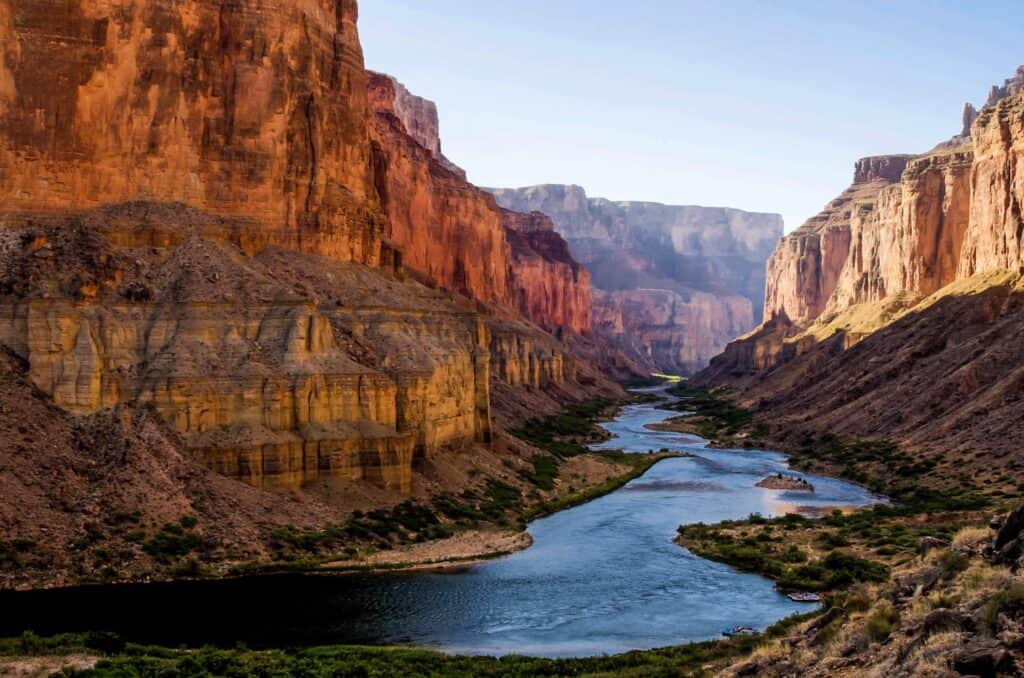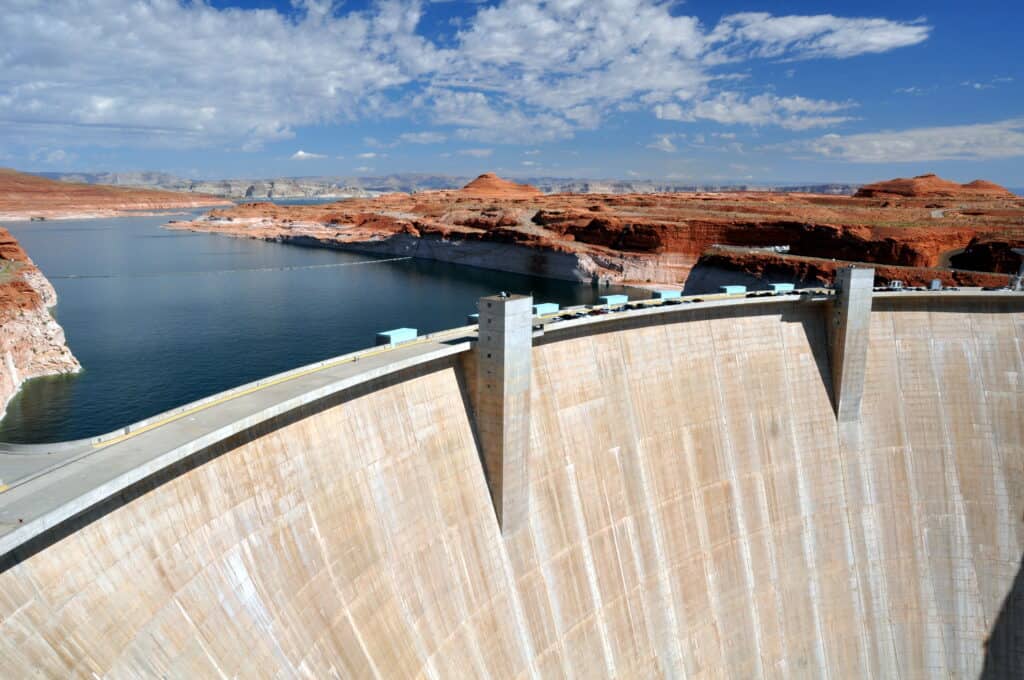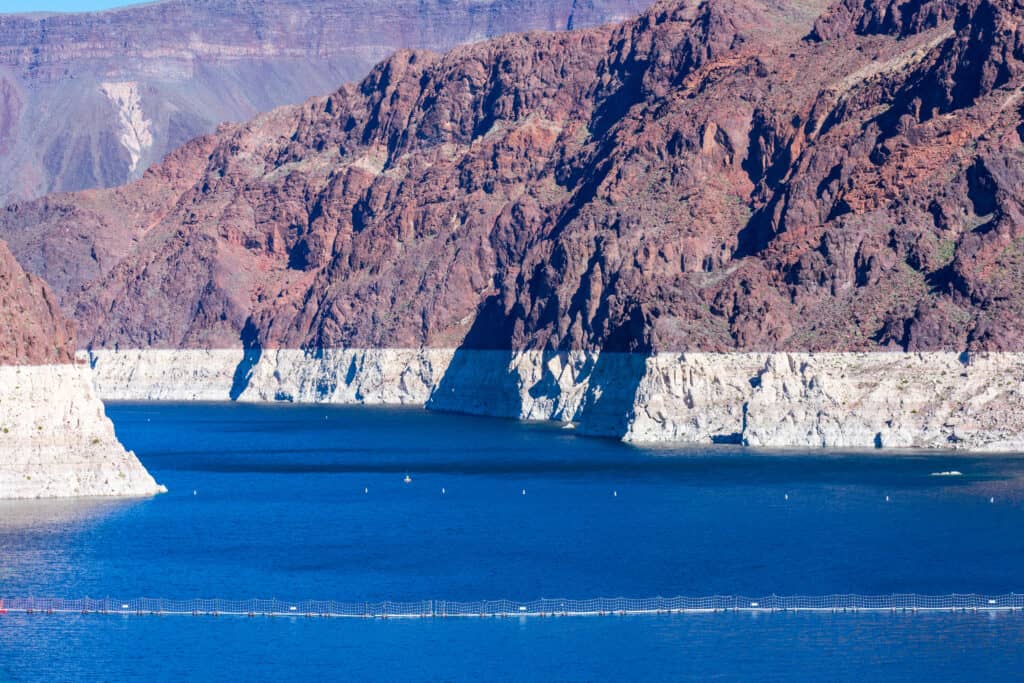Originally known as “Boulder Dam,” Hoover Dam was one of the most ambitious projects of the 1930s. Ever since the first bucket of concrete was poured, the southwest US has never been the same. It’s a massive construction, but just how thick is Hoover Dam and why did they even build it in the first place?
When Was Hoover Dam Built?
People in the southwest U.S. have been trying to tame and control the Colorado River since the beginning of the 20th century. After many unsuccessful attempts, the federal government introduced plans in 1922 to construct a massive dam in southern Nevada near the Arizona border. In 1928, the project was officially approved, and construction lasted from 1931 to 1936. As it neared completion, it was dedicated by President Franklin D. Roosevelt in 1935. It was named in honor of President Herbert Hoover, who had played an important role in getting the project off the ground.
Hoover Dam cost $49 million to build, which would be approximately $760 million today. On top of that, the power plant and generators cost another $71 million. Hoover Dam paid back the cost of its own construction by 1987 through the sale of electricity it generated, so in the long run, the cost of building the dam was effectively . . . free.

One reason for the Hoover Dam’s construction was to prevent flooding from the Colorado River from affecting Arizona and California.
©Beth Ruggiero-York/Shutterstock.com
How Many People Died Building Hoover Dam?
When the dam was originally constructed, it took the creation of a whole new town, the still-standing city of Boulder Nevada, just to provide for the workers. Many people were glad for the opportunity to have a job during the Great Depression, and the project ultimately employed about 21,000 men. With such an ambitious project, builders anticipated injuries. Precautions included a brand-new hospital nearby and specialized “high scalers” who patrolled the cliff removing loose rock. Despite these, 96 men died due to work-related accidents. Contrary to popular myth, they did not bury these people in the concrete of the dam. Today, the Bureau of Reclamation maintains it, which employs around 5000 people.
How Big is Hoover Dam?
At its completion in 1936, it was the largest dam in the world, and while larger dams have been made since, it’s still a monster, holding strong at 726 feet tall, making it the 2nd tallest dam in the United States. At its base, the Hoover Dam measures a width of 660 feet thick, 105 feet wider than the Washington Monument is tall! Even the thinnest part at the top of the dam stretches no less than 45 feet, or the width of a four-lane highway. In all it took 3.3 million cubic yards of concrete to build.
Part of the engineering genius of the dam is that it is built as an arch curving into the massive weight of the water behind it. This shape transfers the weight of the water to the canyon walls so that the dam itself does not bear the full force of it. The Romans used this architectural principle in their construction of bridges, aqueducts, and public buildings. European builders used it for flying buttresses to support the walls of gothic cathedrals. The engineering and materials in Hoover Dam were designed to last for 2,000 years. However, many engineers say that it can actually last for up to 10,000 years and, if humans went extinct, might very well be the last trace of our civilization to remain.

The curved shape of the Hoover Dam operates on the same principle as Roman arches or Gothic flying buttresses.
©Matej Hudovernik/Shutterstock.com
How Much Electricity Does the Dam Provide?
Approximately 20,000 gallons of water rush through the dam per second. All that rushing water flows past blades that spin at 180 rpm, driving 17 turbines, each weighing about 700 tons. This creates a spinning magnetic field that produces a mind-boggling amount of electricity: 4 billion kilowatt-hours of hydroelectric power each year for use in Nevada, Arizona, and California. It’s enough to serve 1.3 million people. Where do those people live? Here’s a list of the places Hoover Dam electricity helps power:
- Metropolitan Water District of Southern California – 28.5% of total electrical output
- Nevada – 23.4%
- Arizona – 19%
- Los Angeles, CA – 15.4%
- Southern California Edison Co. – 5.5%
- Boulder City, NV – 1.8%
- Glendale, CA – 1.6%
- Pasadena, CA – 1.4%
- Anaheim, CA – 1.1%
- Riverside, CA – 0.9%
- Vernon, CA – 0.6%
- Burbank, CA – 0.6%
- Azusa, CA – 0.1%
- Colton, CA – 0.09%

Clean, renewable Hoover Dam electricity helps keep the lights on all night, every night in Las Vegas.
©iStock.com/RandyAndy101
How Much Water Does Hoover Dam and Lake Mead Provide?
Creating electricity isn’t Hoover Dam’s only purpose. It also stores up much-needed water for the driest region of the country, supplying farms and communities up to 300 miles away. It’s no surprise, then, that Lake Mead, the reservoir created by the dam, is the largest reservoir in the nation. At maximum capacity, Lake Mead is 112 miles long, 532 feet at its greatest depth, a surface area of 247.1 square miles, and can hold 9.3 trillion gallons of water. This is about as much water as would normally flow down the Colorado River in two years. About 70% of the water of Lake Meade is for agriculture. Due to a drought lasting back to the year 2000, the water is about 30% lower than normal, revealing all sorts of mysterious secrets, including sunken boats and several dead bodies, some of which were likely the victims of foul play.

The so-called “bathtub ring” around Lake Mead shows just how far the water level has receded in recent years of drought.
©iStock.com/Michael Vi
The Ecological Impact of Hoover Dam and Lake Mead
If we tried to build Hoover Dam today, there’s a good chance it would never pass today’s worker safety standards. It is also unlikely to pass the environmental impact assessments. The damming of the Colorado River changed the natural flow and flooding cycles of the river. The dam disrupted plants and animals and permanently drowned other ecosystems.
It severely damaged the Colorado River delta region where the river flows into the Gulf of California in Mexico. A great deal of damage was done particularly in the first six years after the dam was built. During this time, Lake Mead was still filling, as almost no water reached the delta region. The population of indigenous fish species reduced, and non-native species came into the lake. Four species of fish native to the Colorado River are endangered. These are the bonytail chub, Colorado pikeminnow, humpback chub, and razorback sucker.

Hoover Dam provides flood control for the Colorado River but in the process has disrupted species that were adapted to its flooding cycles.
©iStock.com/Chris Szwedo
What Can You Do at Hoover Dam and Lake Mead?
An iconic landmark such as Hoover Dam, with so much history, provides plenty of things to do. The dam attracts approximately 1,000,000 visitors every year. You can take a tour and see original tunnels and beautiful art-deco art and architecture. You’ll enjoy stunning views from the dam’s viewing platform. You can walk over the world’s tallest concrete arch bridge towering above the dam. No doubt, you’ll find some unforgettable photo ops, just BE SAFE posing for those dramatic selfies!
The Lake Mead National Recreation Area was established around the dam and reservoir. It preserves and maintains the region’s nature and natural recreation potential. Camping and hiking are common activities you can do throughout the protected area. And if you’re more of a sportsman you can obtain an Arizona or Nevada hunting or fishing license. But if nature isn’t your thing, you can check out the distinctly man-made city of Las Vegas. It gleams in the desert only an hour’s drive away. We would describe what you can do in Vegas, but as they say, what happens there, stays there. As you figure that one out, just remember, none of it would likely be possible without the extraordinary Hoover Dam.
The photo featured at the top of this post is © kevin/Shutterstock.com
Thank you for reading! Have some feedback for us? Contact the AZ Animals editorial team.






